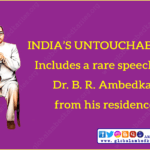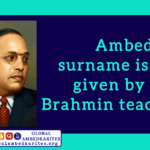
A Simplified brief history of thousands of years of anti-humanism in India… reveals who are the indigenous people of India : Dr. Shrikant Borkar
THE REAL UTOPIA:
Over three (some historians say four to five) thousand years ago the land then known as Jambudeep (also written as Jambu-Dvipa), now the Indian subcontinent, incorporated the Harrapan and Indus Valley civilisations (IVC). This was a naturally mineral rich, fertile and peaceful land. It was progressive because there was liberty, equality and fraternity amongst the Jambu-Dvipa nivasis, the indigenous people of Jambudeep.
We conclude this from the archaeological find from these civilisations, where surprisingly nothing resembling weapons of warfare were found. Common domestic implements were certainly found, which could’ve been used as weapons (Ref. Sept 2016 issue of ‘The New Scientist’- The Real Utopia).
All dwellings were of similar size. People were free to chase their dreams. No wonder it was the most scientifically, socially and morally advanced and creative civilisation in millennia. This was when the rest of mankind lived in comparatively uncivilised, war mongering societies who watched animals tear people apart for entertainment.
The peaceful Jambudeepians, the natives of Jambudeep, now called the MULNIVASIS of India, never likely planned for effective security against any alien invasion. They probably didn’t even know they existed and therefore didn’t feel the need to do so.
(NOTE: The word ‘Mulnivasi’ is not a proper noun. I.e., is not a name given to a person of any group of people but is a common noun which means ‘native’ or an indigenous person. ‘Mul (mool)’ means Root and ‘Nivasi’ means inhabitant)
The current state of affairs in the same land of Jambudeep, modern day India with parts in Pakistan, is obviously not as peaceful and progressive as it was in the golden period of IVC. WHAT HAPPENED? It can only mean that:
EITHER
Those original inhabitants, the indigenous people of modern India did not want to, or did not like to live in peace & security and instead preferred mayhem
OR
Their peace and way of life was disrupted as a result of invasions and mass migrations.
Overwhelming evidence by the ‘Hindu’ and Non Hindu scholars indicate the later. The invasions and migrations occurred over a period of time. It wasn’t a one-off invasion or a one-off mass migration.
AFTER THE INVASIONS:
The invaders, irrespective of where they came from (origin debateable), did in Jambudeep what was considered the norm in that era. They looted, oppressed, committed atrocities of unimaginable magnitude and controlled ALL aspects of the natives’ lives. They became the rulers, the lawmakers, the powerful new masters.[Ref. Rigvedic references of great wars between the natives vs pastoral invaders aryans; Dharmashastra’s as regulatory devices to control the natives].
To ensure their dominance and hegemony, they sealed the fate of the invaded for millennia by devising a hierarchical system of slave labour, from which they believed, would be impossible to escape for they would ingrain it in the psyche of the Mulnivasis. This was the evil caste system. This system of control that Dr BR Ambedkar called “the system of graded degradation”, is to this day the most dominant deciding factor in shaping peoples’ lives.
A certain proportion of the Mulnivasis could not be made to and did NOT fall prey to the vile caste system, not because they resisted but simply because they were out of sight and were either nomads or lived in dense forests and mountains. Other Mulnivasis who did not want to become the ‘oppressed and down-trodden’ fled and joined them out of desperation.
A special term, Adivasi/s, was coined by Thakkar Bapa (Bappa) in 1930 for the purpose of classification to describe these escapees and forest dwellers who weren’t given a caste. Many of those who were nomads left the area and travelled to Eastern Europe. Today’s Romanian gypsies trace their roots to these nomads.
The natives left behind were either labelled ‘Shudras’ or ‘Ati-Shudras’ along with other Mulnivasis. They were the outcasts considered to be untouchables. They weren’t even worth assigning a caste to. Nor was it worth keeping them as slaves for, then there would be that risk of physical touch. It was in the interest of the ALL MALE invading forces to settle in the naturally fertile and mineral rich land of Jambudvipa for their benefit. Who could blame them, for the temptations must have been overwhelming.
The Jambu-Dvipa invaders were the initiators of anti-humanism on a gigantic scale never witnessed in history before, giving rise to the LONGEST SURVIVING SINISTER SYSTEM OF SOCIAL CONTROL IN HISTORY. Even today most of the global population, including scholars are unaware of this stealth system of anti humanism and have failed to recognise it as such.
The invasion of Jambudeep resulted in TWO FACTIONS of people living in the same land:
1. The original Jambudeep nivasis, now known as THE MULNIVASIS (which includes the newly coined term, Adivasi)
AND
2. The invaders, THE MANUVADIS
(Manuvadi: Supporters of societal laws as laid out in the Manusmriti, an ancient Indian scroll containing a stringent law-code attributed to its author Manu, by the Brahmin scholars)
Dr. Shrikant Borkar is a London based social anthropologist and a social activist. He has a doctorate in social anthropology, University of Sussex and is a recipient of Sutasoma Award by Royal Anthropological Institute, UK. His peer-reviewed articles have been published in international journals and magazines. His research interests include transnational modes of social-cultural reproduction, hegemony and processes of social change, knowledge, power and resistance.
Dr. Borkar is a public speaker and a regular participant on TV talk shows on Indian social-cultural and political issues.




